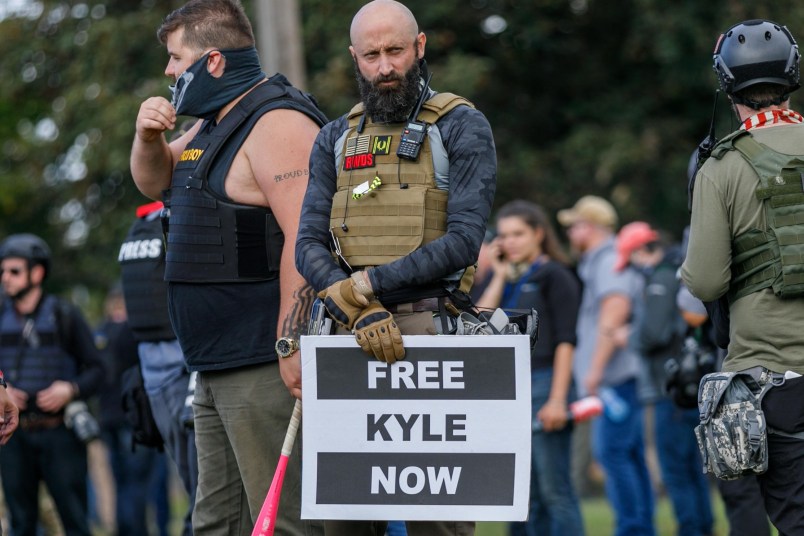Court observers appear divided on whether the Kyle Rittenhouse trial is headed to a hung jury or an outright acquittal. Very few seem to think the case is headed toward a conviction. That’s very jarring because many of us see it as obvious that Rittenhouse is unquestionably the guilty party, even if precisely what he is guilty of may be open to interpretation and despite the fact that the nature of self-defense laws in many states give the defense plenty of room to work with even in a case like this. Setting aside the technical components of first degree murder charges where this trial seems deeply unjust. Rittenhouse traveled to Wisconsin loaded for bear looking for trouble, found it and the law says that’s okay. That is compounded by the way the right in the US has made Rittenhouse into a folk hero.
But I’ve tried to distill down just what gets to me about this case. And here’s what I’ve come up with.
Over the years at TPM we’ve done a lot of coverage not only of the ‘gun rights’ movement but so-called ‘open carry’ activism specifically. These are those cases where men engage in a kind of wingnut performance art by going into restaurants or other public areas carrying various kinds of long guns, most often AR-15s, like the one Rittenhouse used. Many states have made this legal in recent years and these guys want to show they can do it. Open carry types have a whole story about why they do this. But it seems obviously part and parcel of what we now call Trumpism, a form of performative aggression and provocation. People who show up at a local Denny’s or a Walmart with an AR-15 strapped over their back are trying to menace and terrorize people. Because they can. Because it feels powerful.
But the ins and outs of open carry nonsense aren’t what I want to discuss here. It’s rather the trajectory from that to Rittenhouse’s double murder to his expected acquittal. To most of us it is pretty obvious that it’s not good for society to have lots of people walking around in public settings carrying loaded firearms. Open carry activists and ‘gun rights’ supporters generally say that’s all wrong. The problem isn’t guns. The issue is when someone decides to commit a crime with one. If someone shoots someone that’s a crime and it should be punished.
This flies in the face of human nature, common sense and the fact that laws are intended not only to punish crimes but make them less likely to happen in the first place. But let’s take this argument at face value. No one is physically injured by these yahoos strutting around with their AR-15s. The moment that changes we have laws that cover that. Those laws carry severe penalties. So far so good.
But the Rittenhouse case shows how that is not really true. Permissive self-defense laws allow a Rittenhouse to have his aggression double as self-defense. You intentionally go into a chaotic situation. You travel across state lines, highly and visibly armed, allegedly to ‘protect’ people who haven’t asked for your protection. Then you feel threatened, which seems likely to happen in a chaotic place when you show up, chest puffed out with a military style weapon. Your perception of danger entitles you to murderous violence, which you arrived locked and loaded to pursue in the first place. In Rittenhouse’s case part of his perception of threat came when people freaked out after he’d shot and killed the first person. And of course only other people get hurt or killed because you’ve got the over-the-top firepower and they don’t.
If you operate within the chain of reasoning here you see the perverse connections. Self-defense laws exist because we as a society believe you are entitled to defend yourself with what would ordinarily be criminal violence if you face imminent, grave bodily harm or death. If someone breaks into your home and is threatening to kill you you have the right to kill them first. But if you created the dangerous or deadly situation the calculus changes. Or at least it should. Rittenhouse likely broke some laws being there with the gun in the first place. He was under 18 for instance. But the basic argument here is that Rittenhouse wasn’t doing anything wrong by just carrying around an AR-15. Wisconsin’s an open carry state. The inherent aggression and menace of carrying around high caliber weapons, which we’re told is only a problem for squeamish libs, becomes a path for the person carrying the fire arm to themselves feel threatened and decide they need to use the gun.
The aggression carries the seeds of justification within it. You show up looking for trouble on yet another of these right wing murder safaris like Rittenhouse, with his mother chaperoning, was taking part in. You’re looking for trouble and when you find it that’s your justification for taking the next step. That’s not how self-defense is supposed to work. But we can see in this case how the interplay of open carry and permissive self-defense statutes do just that.

 Members-Only Article
Members-Only Article




